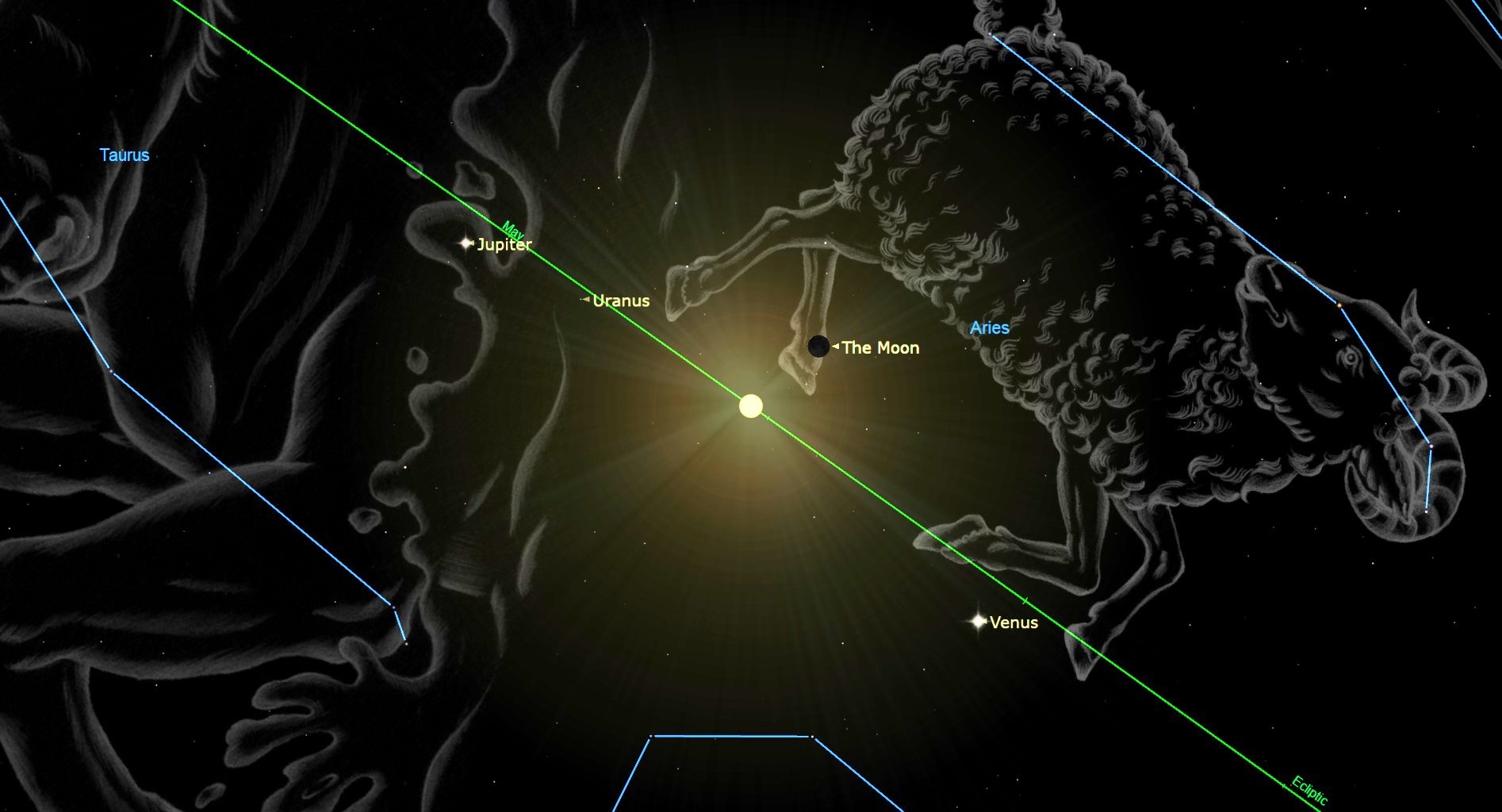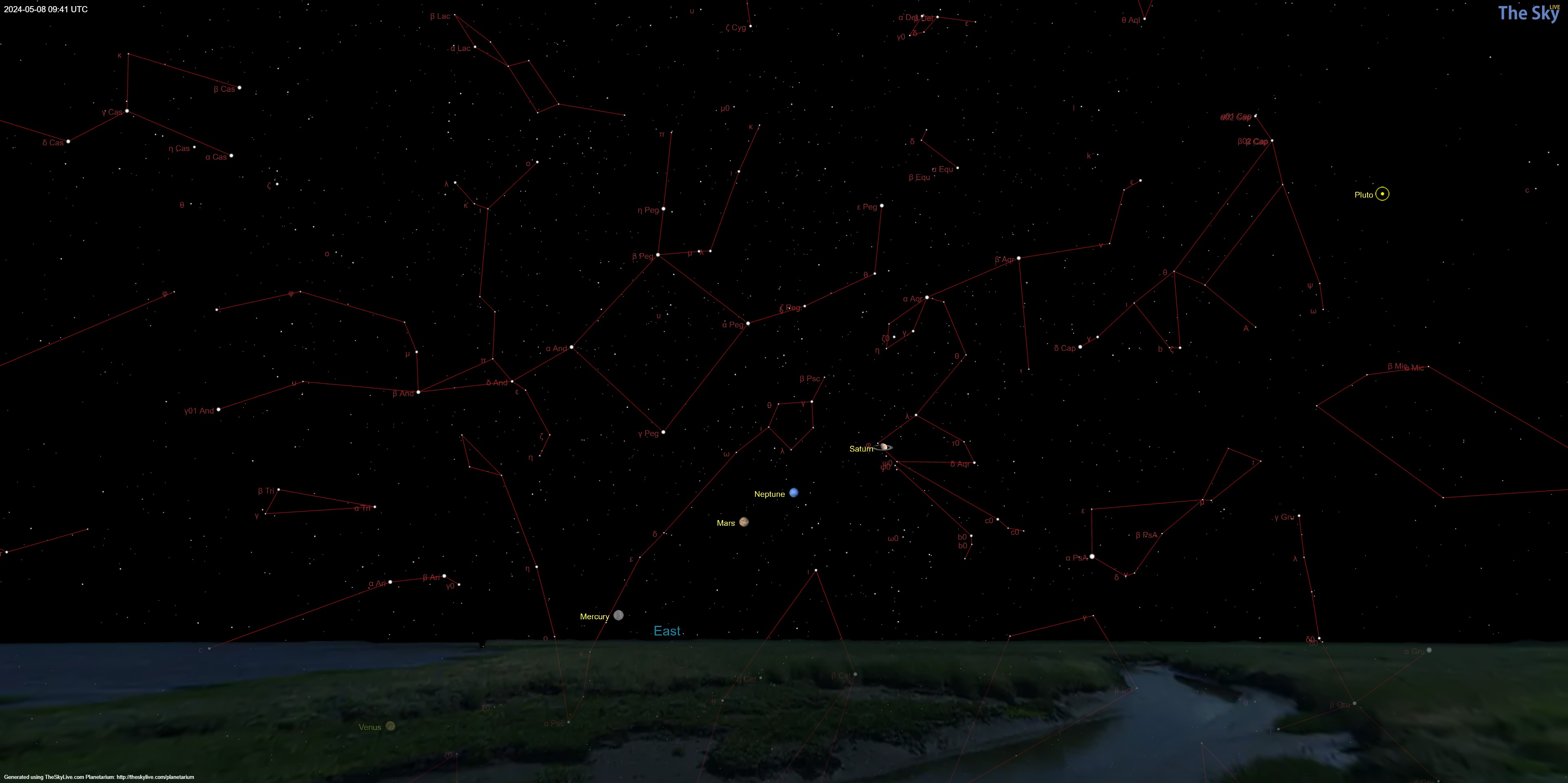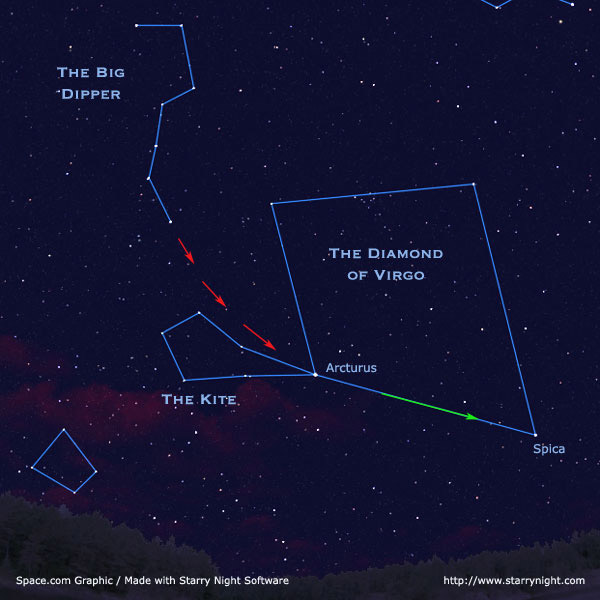New moon of May 2024 tonight welcomes the stars of summer
The new moon of May 2024 will see the bright constellations of summer begin to rise just as those of winter sink below the horizon.

The new moon of May 2024 will see the bright constellations of summer begin to rise just as those of winter sink below the horizon. The same night, Saturn, Mars and (for observers in more equatorial latitudes) Mercury will grace the predawn skies.
The timing of lunar phases depends on the position of the moon relative to Earth, rather than one's position on the Earth's surface. This is why the time the new moon (or any other phase) happens is based on one's longitude and time zone.
The new moon of May occurs on May 7 at 11:22 p.m. Eastern Daylight Time (0322 UTC May 8), in New York, according to the U.S. Naval Observatory. While the moon reaches the new phase at nearly midnight in New York, it happens at 8:22 p.m. in Los Angeles. As one moves east the date moves to May 8; in Cape Town it is at 5:22 a.m., and in New Delhi it is at 8:52 a.m., while in Tokyo it is in the afternoon, at 1:22 p.m.
Related: What is the moon phase today? Lunar phases 2024

Looking for a telescope to look at the night sky during the new mon? We recommend the Celestron Astro Fi 102 as the top pick in our best beginner's telescope guide.
The new moon phase happens when the moon is directly between Earth and the sun. During this phase, they share a celestial longitude, a projection of the Earth's longitude lines on the sky, in an arrangement also called a conjunction.
If the sun and the moon line up perfectly the result is a solar eclipse; the next is due on Oct. 2.
That does not happen most of the time, as the moon's orbit is slightly tilted – about 5 degrees – relative to the plane of Earth's orbit. So seeing the moon in its new phase won't be possible, because of the sun's glare and the fact that the moon is facing away from us; even if we could see it, we'd be looking at the dark side which would just be black on a black background.
Get the Space.com Newsletter
Breaking space news, the latest updates on rocket launches, skywatching events and more!
Visible planets
On the day of the new moon, the sun sets at 7:59 p.m. in New York, per the U.S. Naval Observatory. As one moves north the sun sets later; moving south the opposite happens and it sets earlier; at this time of year the longer days that mark the Northern Hemisphere summer start to become readily apparent. For example in Seattle, which is only seven degrees of latitude north of New York City, the sun sets at 8:31 p.m. Pacific Daylight Time. Meanwhile in Miami it is at 7:56 p.m. local time.
Sunset gets earlier as one moves south because in the tropics, meaning between latitudes 23.5 degrees north (the Tropic of Cancer) and 23.5 degrees south (the Tropic of Capricorn), the day length doesn't change much over the course of the year the way it does in more northerly or southerly regions. In those two latitudes the length of day is between about 10 hours and 40 minutes and 13 hours and 34 minutes; contrast this to cities such as Chicago, where the day is as long as 15 hours 31 minutes and as short as 9 hours 7 minutes. So as one gets closer to the equator as the summer approaches, the length of the day actually gets shorter and the sun appears to set earlier.
In the wee hours of May 8, the first planet to rise is Saturn, at 3:25 a.m. local time in New York City. Mars follows at 4:08 a.m. Last is Mercury, which rises at 4:53 a.m.
Saturn, in the constellation Aquarius, gets to an altitude of 16 degrees by about 5:00 a.m.; at which point the sky is getting light – sunrise in New York City is at 5:45 a.m. Mars by that point is to the left of Saturn, 10 degrees above the horizon almost due east. Mercury is the hardest to spot; it will only reach 6 degrees of altitude by 5:30 a.m.; this will be the case for any location in the mid-northern latitudes (New York City, Denver, Chicago or Sacramento, for example).
Seeing the complete planetary trio is easier as one moves towards the equator; the steeper angle the ecliptic (the plane of Earth's orbit projected on the sky) makes with the horizon the higher they get before sunrise (this is also the reason tropical sunsets and sunrises tend to appear shorter).
From Belize City, for example, sunrise is earlier – at 5:23 a.m. local time on May 8, but Saturn rises at 2:08 a.m. local time, Mars at 3:06 a.m., and Mercury at 4:03 a.m. That means that by 4:30 a.m. Saturn is 33 degrees high, Mars is at 20 degrees and Mercury is 6 degrees above the horizon – the latter an easier observing target than in much of the United States or Europe.

Constellations
In mid-northern latitudes, summer approaches, and it doesn't get fully dark until about 9:00 p.m. local time in New York City or Chicago. The timing will differ somewhat depending on which side of the time zone one is on – Detroit, for example, is on the western side of the Eastern Time zone so the sun appears to set at 8:40 p.m., even though it is at nearly the same latitude as New York, and some locales don't use daylight savings time.
At 9 p.m. the winter stars are making their exit. Castor and Pollux, marking the heads of the famous Twins (Gemini), will still be visible low in the west; Procyon, the bright star in the Little Dog (Canis Minor) will be below them and to the left. If one faces due south (with Gemini on your right) and looks about two thirds of the way up the sky, one sees Leo the Lion, with the constellation's alpha star, Regulus, at the bottom of the sickle-shaped group that marks the Lion's head.
Looking north, one can orient with the Big Dipper, almost directly above the northern horizon, with the bowl upside down and the two stars that point to Polaris, the pole star, on the left side of the bowl. The stars are called Dubhe and Merak, and Dubhe is the one closer to Polaris – one finds Polaris by making a line between the two and continuing until one hits Polaris.
Following the handle of the Dipper one can "arc to Arcturus" –a sweeping motion along the curve of the handle gets you there, to the brightest star in Boötes, the Herdsman. Continuing that arc one hits Spica, the brightest star in Virgo. If one draws a line between Dubhe and Merak away from Polaris one reaches Leo, the Lion.

In the East, Vega, the alpha star of Lyra, the Lyre, is rising, about 10 degrees high by 9 p.m. local time. Vega is one of the three stars of the Summer Triangle, the others are Deneb, the brightest star in Cygnus, the Swan, and Altair, the eye of the Eagle. The latter two will rise by about 11:30 p.m. and be high enough to see easily by midnight. The trio makes a rough right triangle whose narrowest point faces southward, so it is a good direction finder especially as it gets higher in the sky, much the Big Dipper can be used to orient northwards.
By midnight, looking southeast, about 12 to 15 degrees high (depending on how far north or south one is) one will see Antares, the brightest star (the "heart") of Scorpius, the legendary scorpion that killed Orion, the Hunter. Looking above Antares one can see three medium-bright stars that form the head of the Scorpion. From darker-sky locations, above and to the left of Scorpius is the fainter (but much larger) constellation Ophiuchus, the Serpent Holder or Healer.
Ophiuchus can be recognized by a long trapezoid of medium-to-faint stars that extends above Scorpius; initially (at about midnight) he will appear to be lying on his side. On either side of Ophiuchus are the constellations Serpens Caput and Serpens Cauda, the head (Caput) and the tail (Cauda) of the serpents that Ophiuchus holds. Ophiuchus, also named Asclepius by the ancient Greeks, was the healer who brought Orion back to life after the Hunter was bitten by the Scorpion.
In the southern hemisphere, winter is approaching. In Cape Town, for example, the sun sets early, at 5:58 p.m. local time on May 8. That means the sky gets dark enough to see stars by 7 p.m. Observers in mid-southern latitudes can see Orion and Gemini in the northwest near the horizon by that time; Orion will be horizontal with the three stars of the belt making a vertical line; Gemini will be to the right (north) of Orion – both will appear "upside down" relative to what a Northern Hemisphere observer would see; this means that stars like Sirius which is nearly at the horizon in New York or Miami is nearly 50 degrees high in the west.
Turning left (southwards) one can see Canopus at about the same altitude as Sirius; it's the brightest star in Carina, the Ship's Keel. Continue turning eastwards and one sees – again at a similar altitude above the horizon -- the Southern Cross, and just below it is Alpha Centauri, also called Rigil Kentaurus (the "Rigel" of the Centaur). Alpha Centauri is brightest star in Centaurus the Centaur and the sun's closest stellar neighbor. Above Alpha Centauri is Beta Centauri, or Hadar.
Scorpius – "upside down" from the point of view of Antipodeans – will be rising in the southeast lower to the horizon; it becomes fully visible by about 8 p.m. . A fainter constellation just above Scorpius and to the left (east) of Centaurus is Lupus, the Wolf.
Carina is the Keel, as one looks to the right one sees the stars of Puppis, the Poop Deck. A wide circle of stars above Canopus is Vela, the Sail; its brightest star is Gamma Velorum, above and to the left of Canopus. Below and to the left of Canopus is the Large Magellanic Cloud, a satellite galaxy of the Milky way.
The South Celestial Pole, is in the constellation Octans, the octant (an octant is an old astronomical instrument). There's no southern "pole star" – Polaris' alignment with the North Celestial Pole is accidental. One way to locate the Pole is to use the "pointers" in Centaurus, Alpha and Beta Centauri. Draw a line from halfway between those two and another bright star, Achernar, the end of Eridanus, the River, which will be close to the horizon in the south-southwest. The halfway point marks the pole.
Join our Space Forums to keep talking space on the latest missions, night sky and more! And if you have a news tip, correction or comment, let us know at: community@space.com.

Jesse Emspak is a freelance journalist who has contributed to several publications, including Space.com, Scientific American, New Scientist, Smithsonian.com and Undark. He focuses on physics and cool technologies but has been known to write about the odder stories of human health and science as it relates to culture. Jesse has a Master of Arts from the University of California, Berkeley School of Journalism, and a Bachelor of Arts from the University of Rochester. Jesse spent years covering finance and cut his teeth at local newspapers, working local politics and police beats. Jesse likes to stay active and holds a fourth degree black belt in Karate, which just means he now knows how much he has to learn and the importance of good teaching.









